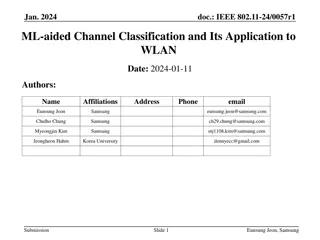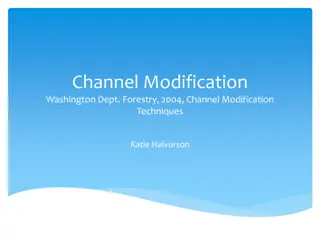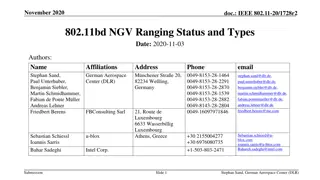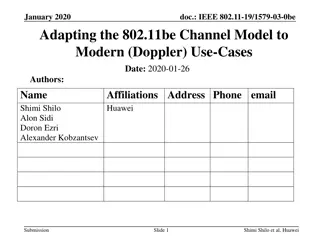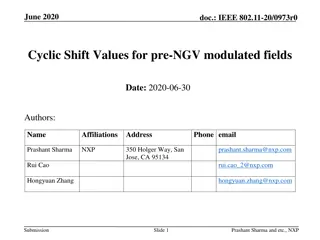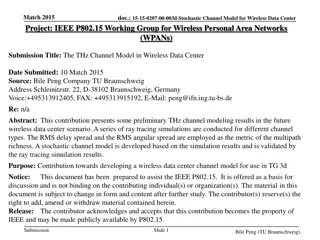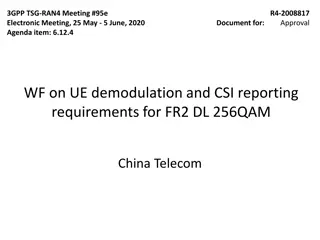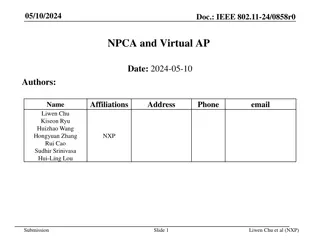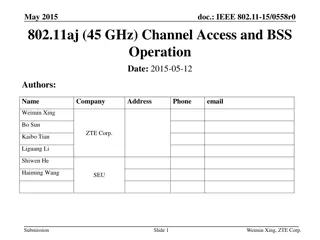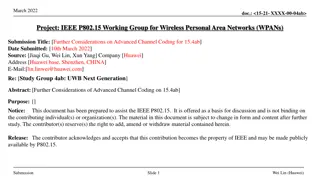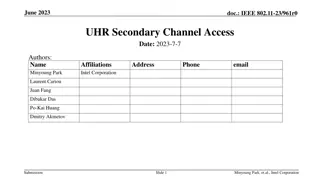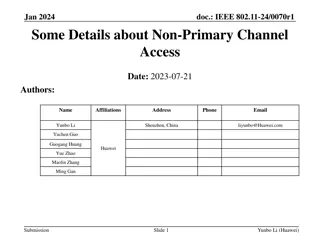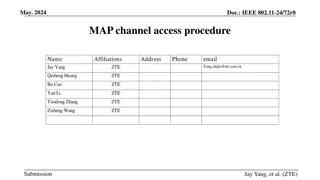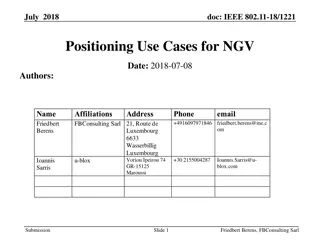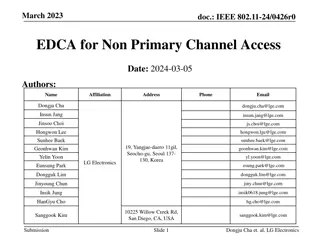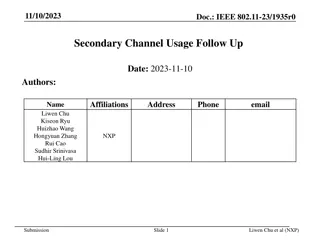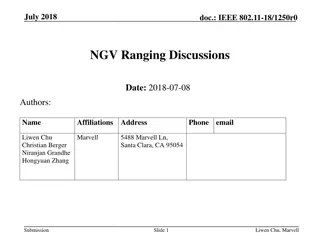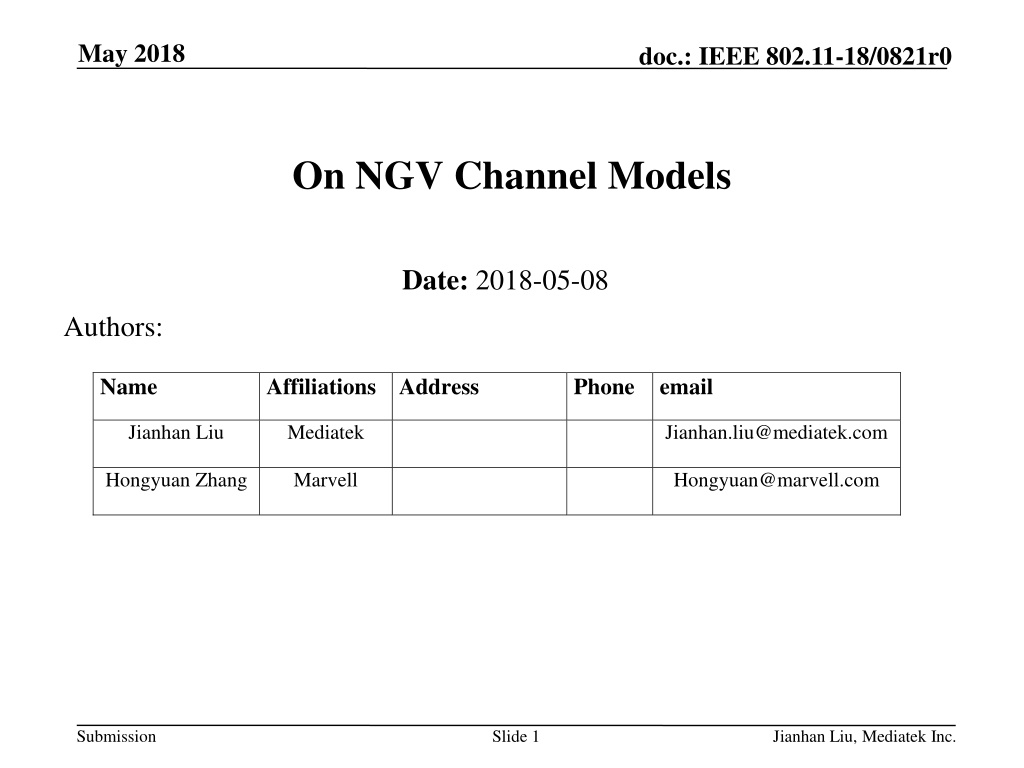
Evolution of IEEE 802.11 Technology for NGV Channel Models
Explore the development of channel models for next-generation V2X communications in IEEE 802.11 technology. Discussing scenarios, channel types, key characteristics, and improvements needed for V2V and V2P channel models.
Download Presentation

Please find below an Image/Link to download the presentation.
The content on the website is provided AS IS for your information and personal use only. It may not be sold, licensed, or shared on other websites without obtaining consent from the author. If you encounter any issues during the download, it is possible that the publisher has removed the file from their server.
You are allowed to download the files provided on this website for personal or commercial use, subject to the condition that they are used lawfully. All files are the property of their respective owners.
The content on the website is provided AS IS for your information and personal use only. It may not be sold, licensed, or shared on other websites without obtaining consent from the author.
E N D
Presentation Transcript
May 2018 doc.: IEEE 802.11-18/0821r0 On NGV Channel Models Date: 2018-05-08 Authors: Name Affiliations Address Phone email Jianhan Liu Mediatek Marvell Jianhan.liu@mediatek.com Hongyuan Zhang Hongyuan@marvell.com Submission Slide 1 Jianhan Liu, Mediatek Inc.
May 2018 doc.: IEEE 802.11-18/0821r0 Introduction IEEE NGV study group has been formed to study the evolution of 802.11 technology for next-generation V2X communications [1]. Channel models needs to be developed for performance evaluation and proposal selection for NGV standard. We discuss the scenario and possible channel models in this contribution. Submission Slide 2 Jianhan Liu, Mediatek Inc.
May 2018 doc.: IEEE 802.11-18/0821r0 What scenarios NGV should consider? Vehicle-to-Vehicle (V2V) Usage: collision avoidance safety systems. Channel Types: Rural, Highway, Urban, LOS and NLOS. Vehicle-to- Pedestrian (V2P) Usage: safety alerts to pedestrians, bicyclists, etc. Channel Types: Rural, Urban, LOS and NLOS Vehicle-to- Infrastructure (V2I) Usage: traffic signal or traffic conditions Channel Types: Microcells for Urban and Rural Key Characteristics for NGV channel models Doppler, Shadowing by other vehicles/buildings/trees and inherent nonstationary. Submission Slide 3 Jianhan Liu, Mediatek Inc.
May 2018 doc.: IEEE 802.11-18/0821r0 11p channel model needs to be improved A comprehensive study of V2V channels was conducted in [2] and it called for improvements for IEEE 802.11p standard and channel modelling. Channel modelling and measurements for V2V and V2I by WiMAX and 3GPP [3] were conducted after 11p. V2I channel models are quite different from V2V and V2P because of antenna heights, shadowing effect, etc.. Worst cases for Doppler shift also need to be considered. Maximum Doppler spread in V2V scenarios can be up to 4 times higher than the Doppler frequency caused by a vehicle's velocity. Submission Slide 4 Jianhan Liu, Mediatek Inc.
May 2018 doc.: IEEE 802.11-18/0821r0 V2V and V2P channel models for NGV Note that NGV channel models for V2V and V2P should be different from 3GPP [4]. E-UTRAN E-UTRAN DL DL UL UL 3GPP V2P 3GPP V2V NGV V2P NGV V2V Submission Slide 5 Jianhan Liu, Mediatek Inc.
May 2018 doc.: IEEE 802.11-18/0821r0 V2V and V2P channel models for NGV Tap1 0 0 0 Static Tap2 -14 83 492 HalfBT Tap3 -17 183 -295 HalfBT Units dB ns Hz Tap1 0 0 0 Static Tap2 -10 100 689 HalfBT Tap3 -15 167 -492 HalfBT Tap4 -20 500 886 HalfBT Units dB ns Hz Power Delay Doppler Profile Power Delay Doppler Profile 144km/hr max differential 252 km/hr max differential Table 5: Rural LOS Parameters Table 8: Highway LOS Parameters Tap1 0 0 0 Static Tap2 -8 117 236 HalfBT Tap3 -10 183 -157 HalfBT Tap4 -15 333 492 HalfBT Units dB ns Hz Tap1 0 0 0 Static Tap2 -2 200 689 HalfBT Tap3 -5 433 -492 HalfBT Tap4 -7 700 886 HalfBT Units dB ns Hz Power Delay Doppler Profile Power Delay Doppler Profile Table 6: Urban Approaching LOS Parameters 252 km/hr max differential Table 9: Highway NLOS Parameters 119km/hr max differential In [5], V2V channel models for the following five scenarios had been proposed by summarizing the measurements from different research institutes. Rural LOS, Urban Approaching LOS, Street Crossing NLOS, Highway LOS, Highway NLOS Tap1 0 0 0 Static Tap2 -3 267 295 HalfBT Tap3 -5 400 -98 HalfBT Tap4 -10 533 591 HalfBT Units dB ns Hz Power Delay Doppler Profile 126km/hr max differential Table 7: Crossing NLOS Parameters Submission Slide 6 Jianhan Liu, Mediatek Inc.
May 2018 doc.: IEEE 802.11-18/0821r0 Channel Model for NGV V2I We can borrow the channel model from 3GPP with minor modifications as NGV V2I models [3]. Parameters Outdoor to Outdoor PL_B1_tot(d) = max(PLfreespace(d), PL_B1(d)) where d is distance between UEs (b) V2I operation PLfreespace is free space path loss (Eq. 4.24 in [6]), PL_B1 is the Winner + B1b ([7] Table 4-1) channel model for hexagonal layout with the following offsets LOS offset = 0 dBc NLOS offset = -5 dBc While calculating Winner + B1 pathloss the following values shall be used h_BS = h_MS = 1.5m, h_BS' = h_MS' = 0.8m Pathloss LOS Probability Shadowing standard deviation Shadowing correlation Fast Fading Winner II-B1 ([6] Table 4-7) 7 dB log-normal i.i.d. ITU-R IMT UMi ([8] Annex 1.3.2) LOS and NLOS Submission Slide 7 Jianhan Liu, Mediatek Inc.
May 2018 doc.: IEEE 802.11-18/0821r0 Summary We propose to adopt the C2C channel model in [5] as the NGV V2v and V2PChannel models. We propose to adopt the 3GPP V2V outdoor to outdoor channel model in [3] as the NGV V2I channel models. Submission Slide 8 Hongyuan Zhang, Marvell
May 2018 doc.: IEEE 802.11-18/0821r0 Reference [1] Hongyuan Zhang and etc., 802.11 For Next Generation V2X Communications , IEEE 802.11-18/0513r2. [2] C.F. Mecklenbrauker, etc., , Vehicular channel characterization and its implications for wireless system design and performance, vol. 99, No. 7, July 2011, Proceeding of IEEE. [3] Study on LTE Device to Device Proximity Services , 3GPP TR 36.843, V12.0.1 (2014-03) [4] Study on LTE-based V2X Services , 3GPP TR 36.885, V14.0.0 (2016-06) [5] IEEE 802.11 Regulatory SC DSRC Coexistence Tiger Team V2V Radio Channel Models , 802.11-14/0259r0. Submission Slide 9 Hongyuan Zhang, Marvell





